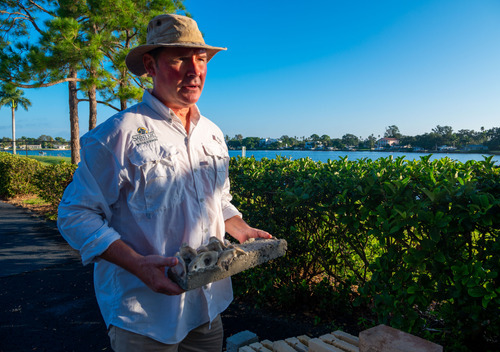 A faculty-student team from the Saint Leo University biology program and a seventh-grade science class from Saint Raphael Catholic School have reached an important step in a new joint ecology project. On a recent morning, everyone met on Saint Raphael's waterfront back lawn to make concrete bricks embedded with recycled oyster shells for placement in the marine waterway along the school's campus. If all goes well, oysters will grow on these bricks, improving water quality for marine life there, and even the broader Tampa Bay.
A faculty-student team from the Saint Leo University biology program and a seventh-grade science class from Saint Raphael Catholic School have reached an important step in a new joint ecology project. On a recent morning, everyone met on Saint Raphael's waterfront back lawn to make concrete bricks embedded with recycled oyster shells for placement in the marine waterway along the school's campus. If all goes well, oysters will grow on these bricks, improving water quality for marine life there, and even the broader Tampa Bay.
For Saint Leo, this experiment is an opportunity to try an approach to oyster reef restoration that differs from the ones commonly seen filmed, where scientists and crews bring in barges and cranes to sink massive spheres encrusted with shells—called oyster balls. Saint Leo's Dr. William Ellis, a marine biologist, wants to approach oyster restoration using small modular components that are easy for children to build and manipulate. Another bonus: this approach can be replicated fairly easily by private property owners with a bit of waterfront access. "We will create proof of the concept," Ellis said.
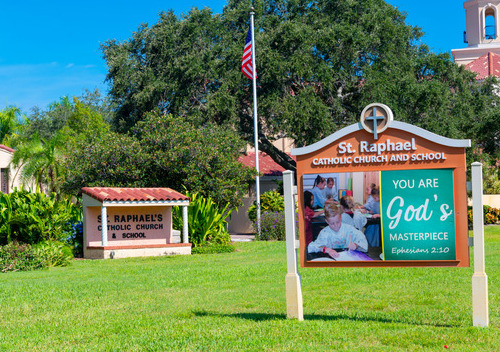 For Saint Raphael's pastor, Father Curtis Carro, a homegrown "oyster garden" is another way of teaching to school students Pope Francis' philosophy of care of the earth, and the related concept that humans are not the creators or owners of the ecology, but the stewards. "Everything is gifted to us," he said. "Creation has been entrusted to us." Middle school students who get to help build the beneficial bricks, and see them in the water, are more apt to embrace the lesson for the long term, the thinking goes.
For Saint Raphael's pastor, Father Curtis Carro, a homegrown "oyster garden" is another way of teaching to school students Pope Francis' philosophy of care of the earth, and the related concept that humans are not the creators or owners of the ecology, but the stewards. "Everything is gifted to us," he said. "Creation has been entrusted to us." Middle school students who get to help build the beneficial bricks, and see them in the water, are more apt to embrace the lesson for the long term, the thinking goes.
Carro, who grew up in the same Florida county (Pinellas), is also hoping that parents and neighbors surrounding the Saint Raphael Church and School area may be positively influenced by what their children see and do. Saint Raphael families, he explained, live near the water in the Snell Isle neighborhood of St. Petersburg, if not on it, and have a direct interest in a healthy marine ecosystem. Children and adults alike remember well a red tide last summer that killed so many fish that the school sometimes had to close down its outdoor summer camp activities, he said. On the worst day, fish were rotting for a length of 200 feet in the waterway along the school's seawall. And Pinellas County has additional ongoing concerns about water treatment, infrastructure, and potentially harmful discharges into Tampa Bay.

In fact, Carro has been working on extending environmental practices at the school campus since being assigned there in July 2020 when this opportunity emerged. Water issues were on his mind. It just so happened that Ellis, who also observes and researches the health of mangrove trees along regional Florida shorelines, noticed the Saint Raphael campus from his skiff one day as he traveled along Smacks Bayou and thought that the site would be ideal for an oyster restoration project. Ellis approached the pastor, and they agreed to collaborate. They soon gained the formal, legal support necessary from Bishop Gregory Parkes of the Catholic Diocese of St. Petersburg, who wrote in a letter that "I am encouraged by the data collected thus far for the viability of oyster gardening and I firmly believe this partnership will allow all to become better educated in the care for God's creation."
Why oysters became key
Scientists and conservationists who have worked on this kind of project start out with recycled oyster shells, affixed to some kind of sturdy structure, or live, growing oysters gathered in metal cages. They do so because new oysters, tiny larvae at the beginning of their lives, like to migrate to static groups of other oysters or oyster shells, forming reefs for protection.
The oysters get their own nutrients by sucking in water and consuming tiny organisms. This process actually helps purify the water. Extra nitrogen in the water, which can cause harmful blooms, is filtered out. The process is efficient too: adult oysters can filter 50 gallons of water a day, making the habitat cleaner for fish and other species. (Ellis noted that oysters that grow in much of Tampa Bay are not suitable for people to eat at this point because of the water quality. Oysters served in Florida restaurants and sold in stores come from other harvest sites.)
Building a starter reef
To make the building-block session at the Saint Raphael campus run smoothly, the Saint Leo team prepared carefully. Ellis and a Saint Leo senior earning her credentials to be a science teacher, Laela Ouellette, visited with the class two days in advance, accompanied by Selena Nieto, a Saint Leo student Ellis recruited from the invertebrate zoology class he is currently teaching. The Saint Leo team wanted to fill the middle-school children in on the science underlying the project, but also wanted them to be excited for the coming outdoor work project. Ellis came ready with clumps of live oyster the size of small, misshapen soccer balls that the students could touch and feel. Finding a variety of invertebrates and fish amongst the oysters really seemed to unleash the students' interest, Ellis noticed.
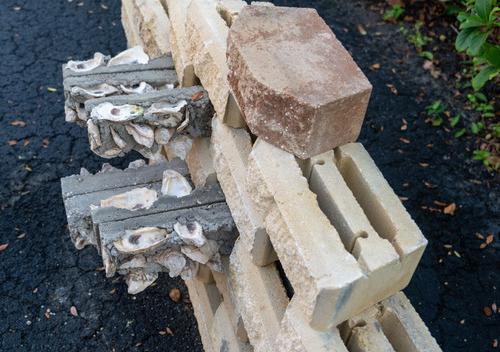 By that Thursday morning, October 7, Ellis had placed a prototype of his modular system in the parking lot of the school. He had assembled a small, low section of wall using the kind of decorative concrete blocks sold in big-box stores; property owners use them to create a border walls around flower beds or to landscape areas of lawn.
By that Thursday morning, October 7, Ellis had placed a prototype of his modular system in the parking lot of the school. He had assembled a small, low section of wall using the kind of decorative concrete blocks sold in big-box stores; property owners use them to create a border walls around flower beds or to landscape areas of lawn.
The prototype Ellis constructed at the Catholic middle school looked like a heavy-set, grey, lattice framework. It was designed with the thought that it would hug Saint Raphael's seawall, and also be anchored into the ground with strategically placed vertical metal bars. Ellis explained all this to the students in person as they formed a semi-circle around the prototype wall. Ellis pulled 16-inch long oyster bricks from spaces purposely left in the wall. The bricks measure only about 3 inches across and 4 inches deep, but are long enough to protrude from the wall out into the water. The volunteers were instructed to cover only half of a 16-inch-long brick's top surface of wet concrete with recycled oyster shell. The resulting shell-covered areas of finished bricks attract new oysters and provide them with nooks and crannies that shelter them from predators.
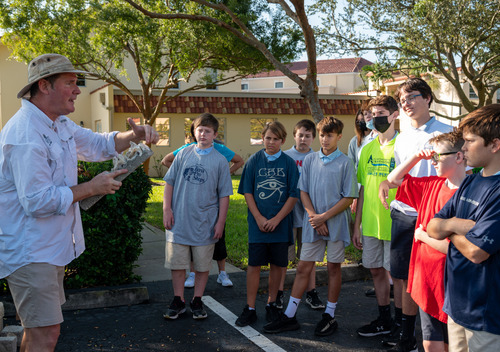
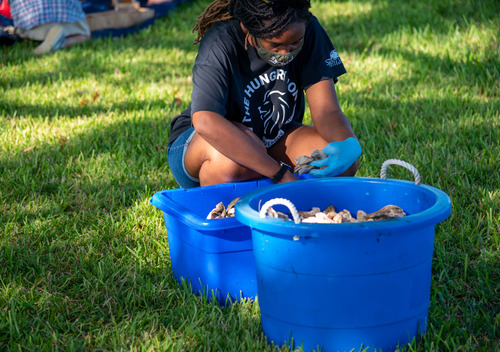
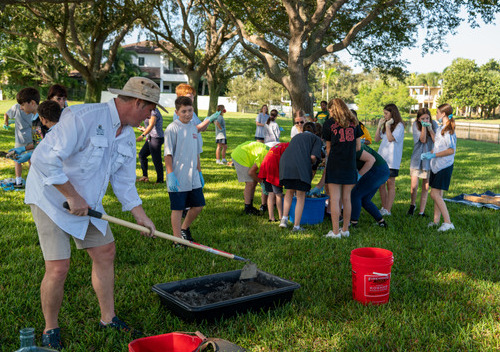
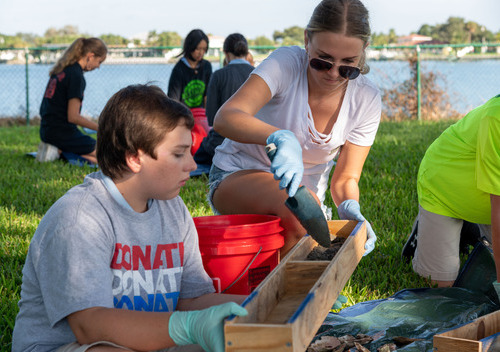
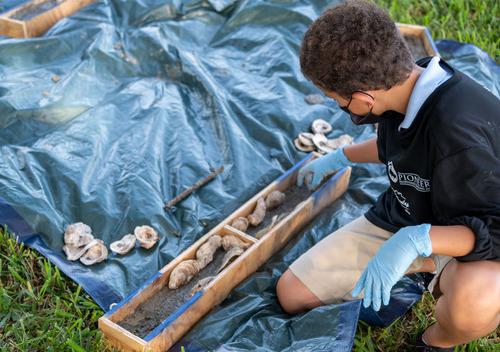
With a clear understanding of their assignments, the Saint Raphael students next gathered out on the lawn, where six tarps had been placed for them to define work areas (and keep concrete from getting concrete on the grass). One Saint Leo student was assigned to each tarp, which had room for four Saint Raphael students. Four hand-built wooden boxes that Ellis built specifically to serve as molds for the students' new bricks were placed on each tarp as well. The Saint Leo student-volunteers relayed specific instructions to the Saint Raphael students, and showed them two large tubs of recycled shells from which they would select their shell pieces, while Ellis stirred concrete mix and water for the basic bricks. Each group got fresh concrete delivered to their tarp in big buckets.
The Saint Raphael students diligently scooped wet concrete from the communal buckets into their individual brick molds with trowels, and chatted with each other and the Saint Leo volunteers at the same time. Their science teacher, Ms. Pat Kranik, visited all the groups to chat with her students as their projects progressed. Ellis was able to make the rounds, too. Saint Raphael students got to trace their initials in wet concrete of the bricks. They were able to use tree twigs set out for them for the purpose.
The outdoor work-project was the first time the future secondary school teacher, Laela Ouellette, had the chance to work with middle-school children. "It's easy to read about these methods in text books," she said, "but being able to see how engaged the kids were the whole time and to see that they wanted to put in the hard work was really great. Working with this age group was definitely different from a high school classroom! This group of students was highly inquisitive and interested in knowing everything we knew."
One Saint Raphael mother posted on social media later that day that her son "would not stop talking about this project."
Next step: planting and observing
As the middle-school students finished up their bricks, Ellis and his students walked two groups of the younger students several yards down the length of the fenced school lawn, right above the seawall. Ellis showed them where their bricks would be placed in the water.
Ellis did the planting of the student bricks one weekend day 10 days after the build project. He soon followed up with additional bricks he had made.
The middle school students naturally want to know how the new oysters and other small fish will act around the new structure, and what differences they oyster bricks will make. So do the adult scientists. Oysters actually start recruiting within days. As scientists want documentation, Ellis and the college students will install two cameras underwater to provide timed video feeds that Saint Leo students will be able to observe remotely. Fish behavior around the oyster garden will be compared to that around bare sea wall. In January, students will count the number of oysters that make the garden their new home.
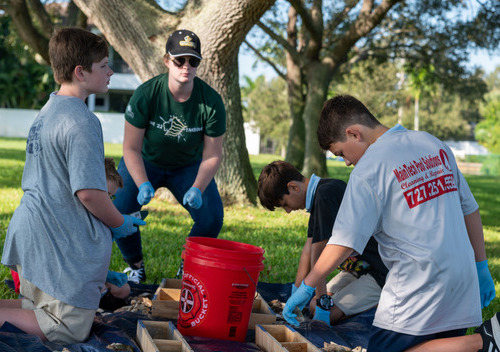 Ouellette, the future teacher, is also planning a parallel project that will begin with the planting. One of her aims is to teach the students the citizen-science skills of measuring the presence of fish in the restored areas. Secondly, she wants to survey students on their confidence in their own science skills, and investigate whether they seem to gain more confidence as time goes on. Rising interest and confidence, Ouellette is hypothesizing, could prompt the younger students to consider a college major or future career in science, technology, engineering or math, the STEM fields.
Ouellette, the future teacher, is also planning a parallel project that will begin with the planting. One of her aims is to teach the students the citizen-science skills of measuring the presence of fish in the restored areas. Secondly, she wants to survey students on their confidence in their own science skills, and investigate whether they seem to gain more confidence as time goes on. Rising interest and confidence, Ouellette is hypothesizing, could prompt the younger students to consider a college major or future career in science, technology, engineering or math, the STEM fields.
Longer-term objectives
Ellis and Carro have ideas to expand the project. Carro has begun looking forward to community and parish events or gatherings when Saint Raphael can draw attention to the oyster farm. And the pastor expects that some of the school children involved are likely to want to take home some of their work to give to parents, grandparents and neighbors with waterfront access to place on their own property; he thinks it would be ideal to influence other waterfront property owners in the neighborhood to install water-quality enhancing oyster fixtures at their own docks and piers, he said.
Ellis said that he could see the student brick-building project being repeated, with more installations following: "Oysters arrive and grow. Grown oyster transplanted everywhere."
"The work," Carro said, "has just begun. I think it's going to be an ongoing effort."
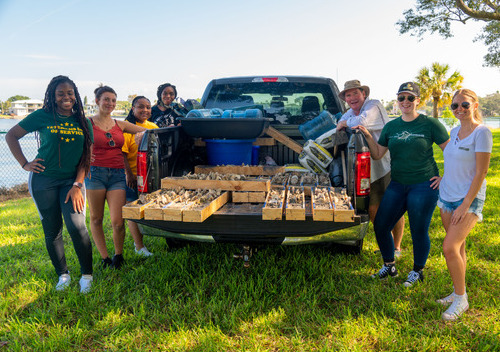
Note: In addition to Ouellette, the Saint Leo University volunteers included: Taylor Galvin, Hannah Morancy, Abigail Moncur, Keanna Amerson, Kenrinique Morris. Selena Nieto, another Saint Leo student volunteer, could not be present for the photo. View more photos.
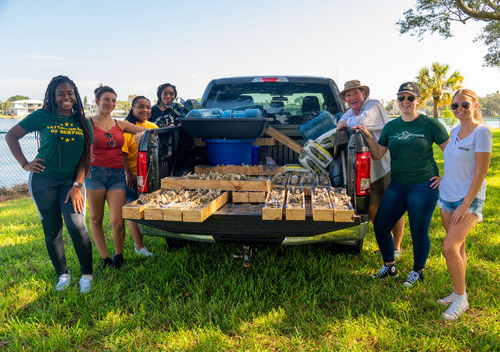
 A faculty-student team from the
A faculty-student team from the  For Saint Raphael's pastor, Father Curtis Carro, a homegrown "oyster garden" is another way of teaching to school students Pope Francis' philosophy of care of the earth, and the related concept that humans are not the creators or owners of the ecology, but the stewards. "Everything is gifted to us," he said. "Creation has been entrusted to us." Middle school students who get to help build the beneficial bricks, and see them in the water, are more apt to embrace the lesson for the long term, the thinking goes.
For Saint Raphael's pastor, Father Curtis Carro, a homegrown "oyster garden" is another way of teaching to school students Pope Francis' philosophy of care of the earth, and the related concept that humans are not the creators or owners of the ecology, but the stewards. "Everything is gifted to us," he said. "Creation has been entrusted to us." Middle school students who get to help build the beneficial bricks, and see them in the water, are more apt to embrace the lesson for the long term, the thinking goes.
 By that Thursday morning, October 7, Ellis had placed a prototype of his modular system in the parking lot of the school. He had assembled a small, low section of wall using the kind of decorative concrete blocks sold in big-box stores; property owners use them to create a border walls around flower beds or to landscape areas of lawn.
By that Thursday morning, October 7, Ellis had placed a prototype of his modular system in the parking lot of the school. He had assembled a small, low section of wall using the kind of decorative concrete blocks sold in big-box stores; property owners use them to create a border walls around flower beds or to landscape areas of lawn.




 Ouellette, the future teacher, is also planning a parallel project that will begin with the planting. One of her aims is to teach the students the citizen-science skills of measuring the presence of fish in the restored areas. Secondly, she wants to survey students on their confidence in their own science skills, and investigate whether they seem to gain more confidence as time goes on. Rising interest and confidence, Ouellette is hypothesizing, could prompt the younger students to consider a college major or future career in science, technology, engineering or math, the STEM fields.
Ouellette, the future teacher, is also planning a parallel project that will begin with the planting. One of her aims is to teach the students the citizen-science skills of measuring the presence of fish in the restored areas. Secondly, she wants to survey students on their confidence in their own science skills, and investigate whether they seem to gain more confidence as time goes on. Rising interest and confidence, Ouellette is hypothesizing, could prompt the younger students to consider a college major or future career in science, technology, engineering or math, the STEM fields.